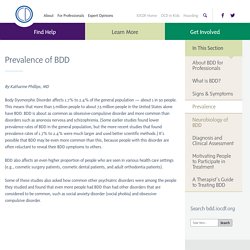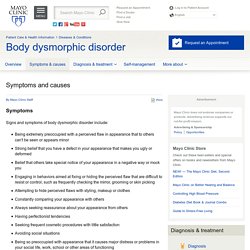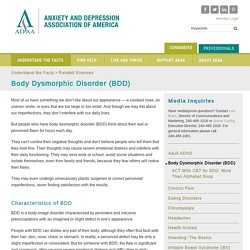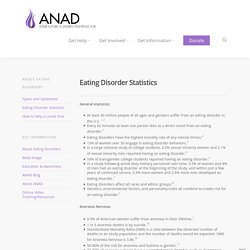

Low Self-Esteem and Drug Abuse: What's the Connection? BDD – Prevalence of BDD. By Katharine Phillips, MD Body Dysmorphic Disorder affects 1.7% to 2.4% of the general population — about 1 in 50 people.

This means that more than 5 million people to about 7.5 million people in the United States alone have BDD. BDD is about as common as obsessive-compulsive disorder and more common than disorders such as anorexia nervosa and schizophrenia. (Some earlier studies found lower prevalence rates of BDD in the general population, but the more recent studies that found prevalence rates of 1.7% to 2.4% were much larger and used better scientific methods.)
It’s possible that BDD may be even more common than this, because people with this disorder are often reluctant to reveal their BDD symptoms to others. BDD also affects an even higher proportion of people who are seen in various health care settings (e.g., cosmetic surgery patients, cosmetic dental patients, and adult orthodontia patients). CMHC Self Esteem. Healthy self-esteem is based on our ability to assess ourselves accurately and still be accepting of who we are. This means being able to acknowledge our strengths and weaknesses (we all have them!) And at the same time recognize that we are worthy and worthwhile. Our past experiences, even the things we don't usually think about, continue to impact our daily life in the form of an "inner voice.
" Although most people do not hear this voice in the same way they would a spoken one, it acts in a similar way, continuously repeating childhood messages to us. For people with healthy self-esteem, the messages of the inner voice are usually accepting and reassuring. Three Faces of Low Self-Esteem Low self-esteem is not always easy to recognize. Facts, Symptoms, Signs, Causes, Medical Impact. Bulimia is a condition where sufferers typically binge and purge.

Bingeing is consuming large quantities of food in a short time, during which individuals feel they have no control over their eating. Purging is the release of that food by self-induced vomiting, laxative abuse or compulsive exercising. Purging is not necessarily used to lose weight. It may be used to demonstrate control or for punishment. Although the number of males who develop eating disorders is increasing, bulimia most frequently afflicts adolescent girls and young women. Medical Impact of Bulimia Frequent bingeing and purging of food can have severe medical consequences. Frequent vomiting can cause other health problems, such as swollen glands, and inflammation or tearing of the esophagus, which can be deadly.
Volunteer for Social Change. Symptoms and causes - Body dysmorphic disorder. Symptoms Signs and symptoms of body dysmorphic disorder include: Being extremely preoccupied with a perceived flaw in appearance that to others can't be seen or appears minor Strong belief that you have a defect in your appearance that makes you ugly or deformed Belief that others take special notice of your appearance in a negative way or mock you Engaging in behaviors aimed at fixing or hiding the perceived flaw that are difficult to resist or control, such as frequently checking the mirror, grooming or skin picking Attempting to hide perceived flaws with styling, makeup or clothes Constantly comparing your appearance with others Always seeking reassurance about your appearance from others Having perfectionist tendencies Seeking frequent cosmetic procedures with little satisfaction Avoiding social situations Being so preoccupied with appearance that it causes major distress or problems in your social life, work, school or other areas of functioning When to see a doctor Causes Risk factors.

Anxiety and Depression Association of America, ADAA. Most of us have something we don't like about our appearance — a crooked nose, an uneven smile, or eyes that are too large or too small.

And though we may fret about our imperfections, they don’t interfere with our daily lives. But people who have body dysmorphic disorder (BDD) think about their real or perceived flaws for hours each day. They can't control their negative thoughts and don't believe people who tell them that they look fine. Their thoughts may cause severe emotional distress and interfere with their daily functioning. They may miss work or school, avoid social situations and isolate themselves, even from family and friends, because they fear others will notice their flaws. They may even undergo unnecessary plastic surgeries to correct perceived imperfections, never finding satisfaction with the results. National Eating Disorders Association.
What Are Eating Disorders?

Eating disorders are real, complex, and devastating conditions that can have serious consequences for health, productivity, and relationships. They are not a fad, phase or lifestyle choice. Eating disorders are serious, potentially life-threatening conditions that affect a person’s emotional and physical health. National Association of Anorexia Nervosa and Associated Disorders. General statistics: At least 30 million people of all ages and genders suffer from an eating disorder in the U.S.

Every 62 minutes at least one person dies as a direct result from an eating disorder.Eating disorders have the highest morality rate of any mental illness.13% of women over 50 engage in eating disorder behaviors.In a large national study of college students, 3.5% sexual minority women and 2.1% of sexual minority men reported having an eating disorder.16% of transgender college students reported having an eating disorder.In a study following active duty military personnel over time, 5.5% of women and 4% of men had an eating disorder at the beginning of the study, and within just a few years of continued service, 3.3% more women and 2.6% more men developed an eating disorder.Eating disorders affect all races and ethnic groups.Genetics, environmental factors, and personality traits all combine to create risk for an eating disorder.
Anorexia Nervosa: Bulimia Nervosa: “Diabulimia:” Facts, Signs and Symptoms of Anorexia Nervosa – Anorexia Disorder Treatment.